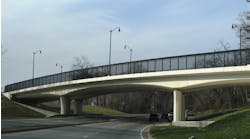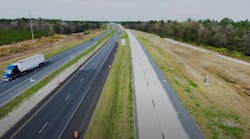Plastic shrinkage cracks are a problem. But most people already know that. In fact, the concrete-pavement industry has been working to eliminate plastic shrinkage cracks for over 50 years.
Recently, industry stakeholders and the Federal Highway Administration (FHWA) worked together to develop a new device for contractors that is a major step forward in the mission to stop plastic shrinkage cracks on concrete-pavement surfaces.
Paving contractors must meet all construction specifications and often are even compensated based on the projected future performance of the pavement structure they deliver. To protect their bottom line while still meeting all the specs, contractors must closely monitor hundreds of factors that influence the construction process. That is a difficult job.
In pavement construction, many inputs affect the outcome. Every detail must be closely monitored, as any changes in design, mixture constituents, subgrade conditions, construction practices and even the weather can produce cosmetically and structurally unsatisfactory roads that will not meet the owner’s requirements.
Environmental conditions surrounding a concrete-pavement project have significant influence on the pavement’s long-term performance. Even with all the right calculations for design and materials for a mixture, newly placed concrete can become more susceptible to damage as quickly as the wind changes. One such phenomenon that can rapidly become a dramatic problem on these projects is plastic shrinkage cracking.
Forming within the first few hours after a concrete pavement is placed but just before set time, plastic shrinkage cracks are typically long, shallow crevices that can form at the surface of the pavement when moisture is allowed to evaporate too quickly from the pavement surface. As moisture evaporates into the air, the pavement surface volume reduces, so the surface shrinks, resulting in stress and ultimately shrinkage cracks. When these cracks occur in excess, they can eventually propagate deep beneath the pavement surface and thus expedite damage due to corrosion and freeze-thaw. Based on the owner’s specifications, the contractor can be held liable for excessive plastic-shrinkage-crack distress and could be required to remove and replace slabs at their own expense.
Beyond plastic shrinkage cracks, environmental conditions also influence how quickly a newly placed concrete pavement gains strength. Changes in humidity levels, wind speed and ambient temperatures on-site can lead to increased evaporation rates and thus decrease the rate of strength gain, which can compromise the entire project.
Evaporating practice
As a concrete pavement cures, it must have a sustained level of moisture available in order for proper cement hydration and strength gain to occur. Evaporation causes moisture loss, leading to shrinkage of the concrete paste, which is plentiful at the surface. When the rate at which evaporation occurs is greater than the concrete’s bleeding rate, differential volume changes occur in the concrete paste and plastic shrinkage cracking becomes a dangerous possibility. Achieving the right cure can be the best way to prevent plastic shrinkage of the concrete paste and thus prevent these cracks.
When it comes to curing pavement, a contractor can choose from a variety of curing methods. These include continuous fogging, applying membrane-forming compounds or cure compound, or covering the pavement with impervious paper or plastic sheets. A contractor also may decide to cover the pavement with burlap, cotton mats, rugs or other fabrics, or earth, sand or sawdust. Increased evaporation rates also can be avoided by installing wind-breaking shelters and sunshades over the pavement. The use of evaporation retardants is another common practice.
Previously, an experienced contractor or inspector could tell when cure needed to be applied simply by watching the surface of the concrete and waiting for initial set to occur. Evaporation rate could be estimated by a visual inspection. However, concrete-mixture designs are becoming more innovative and often incorporate new chemicals and mineral mixtures that make visual determinations of when to apply the right cure much less intuitive.
Using a technical nomograph, American Concrete Institute Committee 308 developed guidelines many years ago for curing concrete that include a method of calculating evaporation rates. The nomograph was a major step forward to help the industry better prevent plastic shrinkage cracks. The guidelines require contractors to constantly monitor ambient weather conditions and concrete temperatures if they desire a continuous measurement of evaporation rates.
Over the years, as contractors have been asked to do more with less resources, this has become less practical. Therefore, evaporation rate is typically not continuously measured in the field. The unfortunate reality, however, is that critical weather conditions may be occurring without the contractor’s awareness. As a result, the overall quality of the concrete pavement may be compromised.
If concrete is being placed on a warm, sunny day, but the skies suddenly become overcast, temperatures drop and the winds increase, a contractor should consider that the time to apply cure may have changed. When ambient conditions change enough to cause evaporation to occur faster, a more immediate action is required. An automated way to determine when to apply cure—based on continuous measurements of ambient weather conditions and concrete surface temperatures throughout an entire day’s worth of paving—would be very beneficial to any contractor. If there were a way to put evaporation rate information into the contractor’s hands in an easier manner, contractors would be more likely to use the information to select the optimal curing method and prevent plastic shrinkage.
Smart thinking
Recently, the FHWA sponsored a research project that resulted in the development of an intelligent system that makes continuously monitoring evaporation rates a reality. The system, called SmartCure, has been developed by pavement and material engineers at the Transtec Group and addresses the problem of knowing when and how to cure, and therefore simplifies the entire process.
Benefiting from an integration of software and hardware, SmartCure is able to produce accurate estimations of real-time conditions, so that the contractor can make the best-informed decision for their project. SmartCure is a compact, portable hardware/software tool that measures current climatic conditions and displays the prevailing evaporation rate of moisture from the concrete surface. The SmartCure system includes a portable weather station, an infrared sensor for monitoring concrete surface temperatures and a GPS unit for location tracking. Data about the environmental conditions and concrete surface temperatures are recorded to a portable computer as the pavement is placed. The data is fed into the software, which calculates an evaporation rate and alerts the contractor when changes in surrounding climate conditions require changes in curing procedures.
SmartCure helps contractors know when to cure by allowing them to customize their experience with user-defined inputs for critical thresholds based on the specifics of each project. Users can identify which temperatures and evaporation rates are important to them, and in return, the software monitors the entire paving process, warning the user if there is a risk of impending damage due to an inadequate cure. Alternatively, a contractor can optionally rely on built-in default thresholds. SmartCure is designed to help pavement contractors build higher-quality pavements under changing climate conditions.
A SmartCure prototype was built and evaluated as part of the initial development of the system in 2007. Real paving projects in Houston, Kansas City, Mo., and Martinsburg, W.Va., provided the opportunity for engineers to test SmartCure’s ability to perform in the field. The system was able to monitor the surrounding climate without fail, despite varying temperatures, humidity and wind speeds. Both developers and contractors during these field trials concluded that the SmartCure system significantly improved the contractor’s ability to adjust curing methods as needed and prevent plastic shrinkage cracks.
During this evaluation, developers also learned that the system would even better meet a contractor’s needs by transmitting data wirelessly. Under sponsorship from the FHWA, engineers at the Transtec Group are currently completing the development of a wireless version of the tool.
In terms of building roads, new and innovative techniques for concrete mixtures and construction methods are changing the needs of today’s contractors in order for them to stay ahead of the game. Technologies like SmartCure are becoming more necessary for contractors to keep a competitive edge.


